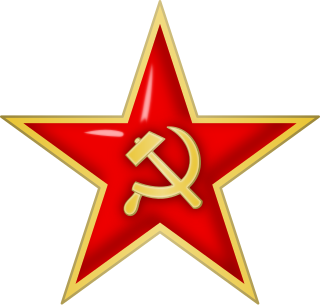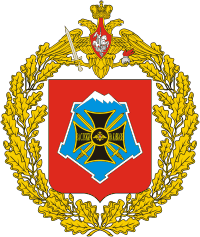The 1st Guards 'Vienna' Order of Lenin Order of Kutuzov Mechanized Corps was a Red Army armoured formation that saw service during World War II on the Eastern Front. After the war it continued to serve with Soviet occupation forces in Central Europe. It was originally the 1st Guards Rifle Division. The unit had approximately the same size and combat power as an early-war Wehrmacht Panzer Division, or a British Armoured Division during World War II.
The 6th Army was a field army of the Soviet Red Army formed four times during World War II and active with the Russian Ground Forces until 1998. It appears to have been reformed in 2010.
A rifle corps was a Soviet corps-level military formation during the mid-twentieth century. Rifle corps were made up of a varying number of rifle divisions, although the allocation of three rifle divisions to a rifle corps was common during the latter part of World War II.
The 8th Rifle Division was a military formation of the Soviet Union's Red Army in the Winter War, the Soviet invasion of Poland, and World War II. It was formed three times.
The 316th Rifle Division was formed as a Red Army division during World War II. The division was initially formed in July 1941, renamed the 8th Guards Rifle Division on 18 November 1941. The division was recreated at Vjasniki in July 1942, fought in the early battles around Stalingrad and was disbanded in November 1942. The division was recreated for the third time from the 57th and 131st Rifle Brigades in September 1943. The division ended the war assigned to the 27th Army of the 3rd Ukrainian Front.
The 7th Guards Cavalry Corps of the Soviet Union's Red Army was a cavalry corps active during the Second World War. It was formed from the 8th Cavalry Corps in February 1943.
The 32nd Cavalry Division was formed in 1938 in the Kiev Military District from the 1st Zaporozhe Cossack Cavalry Division.
The 43rd Cavalry Division was one of the first cavalry divisions formed after the start of the war. The unit was formed in the North Caucasus Military District using the cadre and troops of the district's cavalry training grounds.
The 47th Cavalry Division was one of the first cavalry divisions formed after the start of the war. The unit was formed at Novocherkassk in the North Caucasus Military District from reservists and the cavalry depots in the district's cavalry training grounds.
The 18th Mountain Cavalry Division was formed in 1936 by renaming the 7th Tadzhik Mountain Cavalry Division in the Central Asia Military District.
The 24th Cavalry Division was a prewar division assigned to the Transcaucasus Military District on 22 June 1941. The division was assigned there after participating the Winter War.
The 82nd Cavalry Division was formed from August to 18 October 1941 in the Sverdlovsk Oblast in the Urals Military District.
The 31st Army was a field army of the Red Army during the Second World War.
The 32nd Army was a formation of the Soviet Army during World War II. The army was formed twice during the war, disbanded as part of the post-war demobilization and then reformed in 1969 to protect the Soviet-Chinese border.

The 5th Shock Army was a Red Army field army of World War II. The army was formed on 9 December 1942 by redesignating the 10th Reserve Army. The army was formed two times prior to this with neither formation lasting more than a month before being redesignated.
The 42nd Rifle Division was a unit of the Red Army during the Great Patriotic War. The division, first formed in 1940, was nearly destroyed in the opening days of the Operation Barbarossa defending the Brest Fortress. Disbanded in late December 1941 and immediately reformed in the Volga Military District. The division then served on the front until disbanded at the end of the war.
The 301st Rifle Division began service as a standard Red Army rifle division shortly after the German invasion, but was soon largely destroyed in the encirclement of Kiev, although enough of a cadre survived to form the basis of a second formation. This new division began forming in the last days of 1941, and saw some limited service in the Second Battle of Kharkov, but then had to fall back in the face of the German summer offensive, became encircled quite early on, and had to be disbanded in July. Nearly a year later a third 301st was raised, based on the personnel and equipment of two existing rifle brigades. This incarnation of the division compiled a creditable record of service in several major offensives through Ukraine, then into Poland and into the heart of Berlin in April, 1945, and also served briefly post-war in the Group of Soviet Forces in Germany, headquartered in Berlin.
The 292nd Rifle Division was an infantry division of the Soviet Union's Red Army during World War II, formed three times.
The 365th Rifle Division began forming on September 1, 1941, as a standard Red Army rifle division, in the Sverdlovsk Oblast. After forming, it was assigned to the 30th Army of Western Front, served briefly in the defense of Moscow, and played a role in the liberation of Klin, and later in the near-encirclement of the German 9th Army around Rzhev in the winter counteroffensive of 1941-42. In late January, 1942, it was transferred to the 29th Army of Kalinin Front, which was very soon after encircled by German forces near Sychevka, and on March 18 the division was disbanded due to very heavy losses. In November, 1944, a new 365th Rifle Division was formed in the Far Eastern Front, based on the 29th Rifle Brigade, and saw action in the Soviet invasion of Manchuria in August, 1945, being awarded the Order of the Red Banner for its services.



